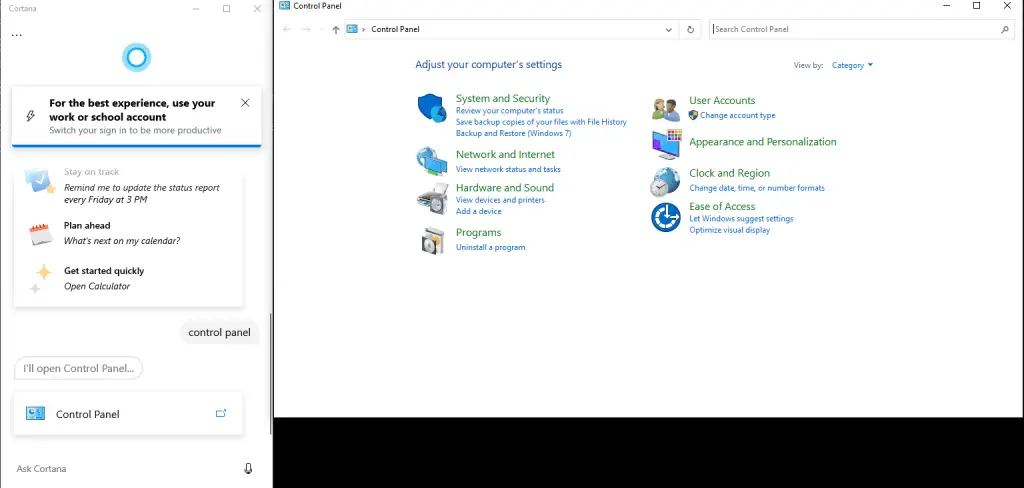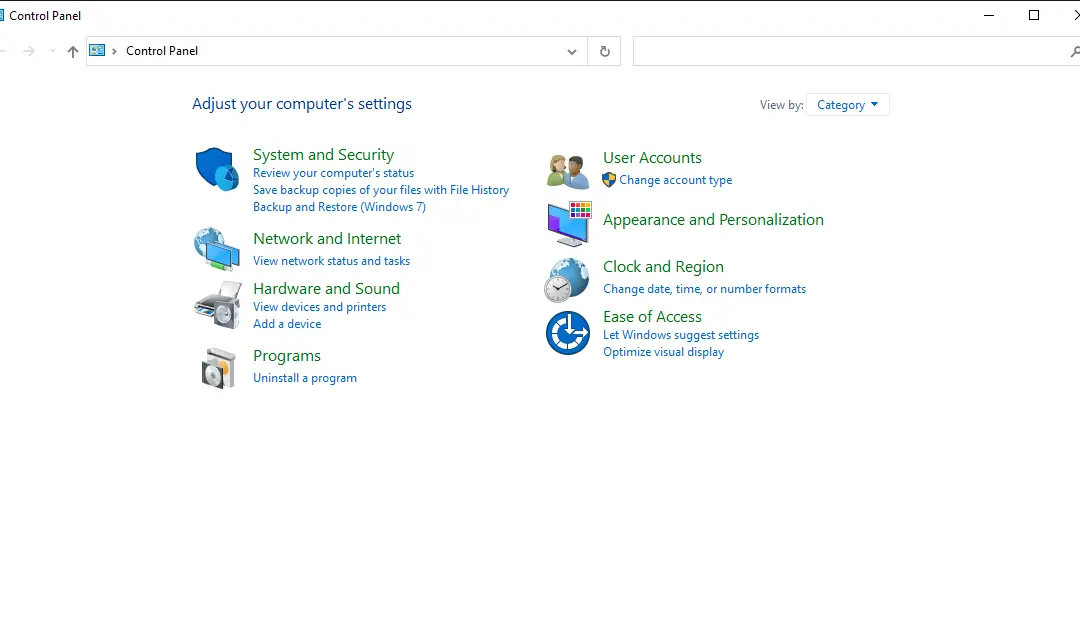Microsoft is working to replace the tried and true control panel with the new Settings app. It is ‘Ok,’ but there are several things that are harder to do or not present. Also, if you are like me and have been doing it a while, you might just be used to where things are in the old Control Panel.
Here I give you 14 ways to open the Control Panel since having alternative ways lets you find something that fits your needs, or if you have a problem with part of your system not working, you may be able to find another way to get to what you need to do.
If I missed anything, please let me know in the comments section.

Windows Start Menu Fast
The Start Menu gives you several options for getting to the Control Panel.
Windows Search
- Click the Start Button or hit the windows key on your keyboard
- In the Start Menu, you don’t even need to click anything. You can start typing
- Type Control Panel

Pin To Start Menu
At any point, you can right-click the icon for the Control Panel and “Pin to Start” this places an easy-to-access shortcut in your Start Menu.


Pin To Taskbar
Like we just pined the shortcut to our start menu for easy access, we can pin it to our Taskbar for even easier access! You don’t have the start menu with this setup, as the Taskbar is almost always visible.


Address Bar (File Explorer)
My preferred method to access the Control Panel is using File Explorer and the Address Bar. I like this since I almost always have a File Explorer or several open, and I can get there with as little as two clicks.
Dropdown
- Open your File Explorer window and click the “>” character in the Address Bar.

- Click Control Panel from this menu
Type the Address
- Click on the Address Bar
- Start typing or fully typing “Control Panel.”
- Press Enter

Command Line
At first, I couldn’t get the command line option to work, but I figured I was doing some things wrong.
The first issue was using a custom command I had built on my machine. I’ll make a post about using such commands soon. The second issue is related to the first since I didn’t have this custom command in place; I was obviously using the wrong command the entire time. The correct command to get the control panel open is the following:
shell:controlpanelfolderPowerShell
Like the Command Line version, I used the incorrect command when I first wrote this article, and the same command for the cmd line works in PowerShell.
shell:controlpanelfolder“Run” Window
You can open the run window by clicking the Windows Key + R; click here for more ways to open the Run Window.
Once you have that open, you can type in “control” or “control panel.”

You can also right-click the start menu and open the “Run” window.
Task Manager
I made a video some time ago about the many ways to open Task Manager. No matter how you get it open, there is a run task command we can use to run Control Panel.
- Open Task Manager
- Click File > Run New Task
- Now just like using the “Run” window, you can type “Control” or “Control Panel” either will work.
Run the Executable
Suppose you are brave enough or face enough issues using other methods. It might be time to get to the system level and open the EXE file directly. You can double-click or right-click > open.

Create Shortcut
Maybe you missed the memo and have been missing out on one of the most excellent Windows secrets. You can turn most things into shortcuts, and the Control Panel is no exception. Right-click the control.exe file and click Send to > Desktop (create shortcut).

Click From Program List
When you click the Start button, you can scroll a list of programs through, leading us to the “Windows System” folder. Inside this folder is the Control Panel icon!

Create A Script
In the future, I will have an entire section of this website devoted to scripting and creating your own tools. This method is a straightforward way to get a script started, and later if we add this to our Environmental Variables, we can make our Control Panel open with a custom command.
- Start by picking a location for your script. I chose documents.
- Right-click to create a new file and select New > Text Document
- Windows will create a new File, and as long as it says “New Text Document.txt” with the extension txt included, this will be easy. If not, check out this article on turning on file extensions in File Explorer.

- Change the name to something you will easily remember. For me, I used “CPL,” now add a .bat to the end of that file name you chose. Mine was CPL.bat
- Enter the location for your shortcut file to the Control Panel, the EXE, or the shell command as shown below (quotes included). Replace “YourUser” with your user name if you use the local shortcut file. However, I recommend using the shell command.
"C:\Users\YourUser\AppData\Roaming\Microsoft\Windows\Start Menu\Programs\System Tools\control panel.lnk"or"C:\Windows\System32\control.exe"orshell:controlpanelfolder
The last optionshell:ControlPanelFolderwill have better portability.
- Save and run!

Windows Settings Search
if you are already using the new Settings App to make some changes but are not finding the setting or tool you need, you can open the Control Panel directly from the Settings App by searching for “Control Panel”:

Ask Cortana
I like Cortana and enjoy using it. You can directly type into Cortana what you want or click the microphone icon to search for things or complete tasks. In this instance, we type in Control Panel, and she opens it for us.

Create A Shortcut Ver. 2
If you right-click in a folder or on your Desktop, you can create a shortcut to almost anything.
- Right-click where you want the shortcut to happen and click New > Shortcut

- Either browse to the Windows > System32 folder and select control.exe to create your shortcut or directly type the address into the location bar:
C:\Windows\System32\control.exe - Click next, and you can name the shortcut if you don’t want it to say Control.exe.

There you have it! Several methods you can use to open the Control Panel. I’ll work on updating and expanding this list soon. It has been an enormous help to know alternative paths to accomplishing tasks, especially when things aren’t going as planned.
I hope that helps!

